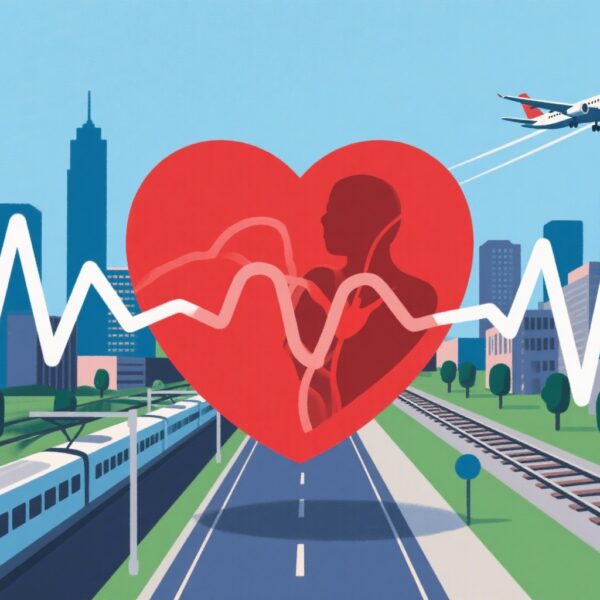Highlight
- Exposure to outdoor air pollutants, especially PM10, is associated with elevated allostatic load in children aged 6-11 years across six European cohorts.
- Air pollution predominantly affects the immune/inflammatory and metabolic physiological systems in children, indicating systemic stress responses.
- No significant association was observed between residential road traffic noise and allostatic load in this pediatric population.
- Findings underscore air pollution as a chronic stressor with potential long-term health consequences starting in early childhood.
Study Background
The burden of chronic diseases linked to environmental exposures increasingly points to the importance of early-life influences. Outdoor air pollution and road traffic noise are pervasive urban environmental stressors implicated in triggering physiological responses that can ultimately contribute to disease development. These stressors are hypothesized to instigate allostatic load—a cumulative measure of physiological wear and tear across multiple systems—mediated by neuroendocrine, metabolic, cardiovascular, and immune pathways. While animal and adult human studies have suggested these links, pediatric epidemiological evidence remains limited. Understanding these influences during sensitive windows in children is critical, as physiological dysregulation at this stage may predispose to chronic disease later in life.
Study Design
This investigation analyzed data from 919 children aged 6-11 years participating in the Human Early Life Exposome (HELIX) project, encompassing six European countries. The cohort study integrated exposure assessment and biomarker data.
Outdoor air pollution exposures quantified included nitrogen dioxide (NO2), particulate matter under 2.5 micrometers and 10 micrometers (PM2.5, PM10), and PM2.5 absorbance (a marker of black carbon). Road traffic noise was estimated as day-evening-night noise levels (LDEN) using geospatial modeling for participants’ home, school, and commuting routes, representing the year prior to biomarker assessment.
Allostatic load was operationalized using 19 biomarkers representing four physiological systems: cardiovascular, metabolic, immune/inflammatory, and neuroendocrine. Both count-based and continuous allostatic load scores (range 0-19) were computed to quantify systemic physiological dysregulation.
Key Findings
Overall, the study demonstrated positive associations between ambient air pollutant levels and increased allostatic load scores in children. Among pollutants, PM10 showed the most robust and statistically significant relationship after correction for multiple testing:
- For each 10 µg/m3 increase in PM10, the count-based allostatic load score relative risk (RR) was 1.27 (95% confidence interval [CI]: 1.08-1.48).
- The continuous allostatic load score similarly showed a significant increase (β = 0.56; 95% CI: 0.27-0.84).
When analyzing physiological systems separately, air pollution was primarily associated with increased dysregulation in the immune/inflammatory and metabolic systems, suggesting prominent inflammatory and metabolic stress pathways in response to pollution exposure.
Interestingly, no statistically significant associations were observed between road traffic noise exposure and allostatic load outcomes, indicating that noise may not contribute similarly to multisystem physiological stress in this age group or under the conditions assessed.
Expert Commentary
This pioneering multi-cohort study provides important epidemiological evidence linking childhood exposure to air pollution with measurable systemic physiological stress. The use of allostatic load as a composite biomarker metric enables insight into multisystem health impacts beyond isolated clinical endpoints. The emphasis on immune and metabolic systems aligns biologically with known inflammation and metabolic disruption mechanisms triggered by particulate matter.
However, several limitations warrant consideration. Being observational, causality cannot be definitively established. Potential confounders such as socioeconomic status, indoor exposures, and individual susceptibility may influence results, though the multicenter design and comprehensive biomarker panel strengthen internal validity.
The null findings regarding traffic noise do not exclude other health effects but suggest noise may not impose systemic allostatic burden at this age or require alternative exposure metrics or sensitive windows of assessment.
Future research should investigate longitudinal impacts, mechanistic pathways, and interactions between multiple environmental stressors to better inform preventive interventions and policy regulations aimed at protecting child health.
Conclusion
This study substantiates the role of outdoor air pollution as a chronic environmental stressor elevating allostatic load in children, reflecting multisystem physiological dysregulation that may foreshadow future disease risk. The absence of observed effects from road traffic noise underscores the specificity of air pollution impacts on physiologic stress pathways. These findings emphasize the importance of controlling air pollution exposures during early life to mitigate long-term health consequences. Clinicians and public health stakeholders should recognize the systemic health threats posed by pollution and reinforce efforts towards cleaner environments for children.
Funding and ClinicalTrials.gov
The study was funded by European research grants associated with the HELIX project consortium. No specific clinical trials registry applies to this observational cohort analysis.
References
- Mou Y, Kusters MSW, Robinson O, et al. Outdoor air pollution, road traffic noise, and allostatic load in children aged 6-11 years: evidence from six European cohorts. Eur J Epidemiol. 2025;40(5):537-548. doi:10.1007/s10654-025-01227-8.
- McEwen BS. Protective and damaging effects of stress mediators. N Engl J Med. 1998;338(3):171-9.
- Esposito MA, et al. The early-life exposome and child health: An overview of lessons learned and key priorities. Environ Int. 2022;161:107127.



